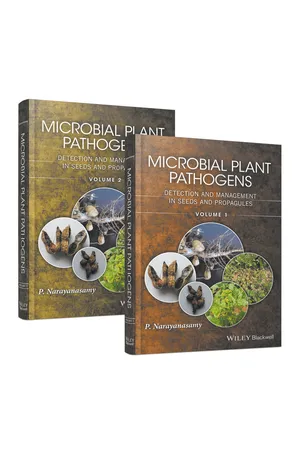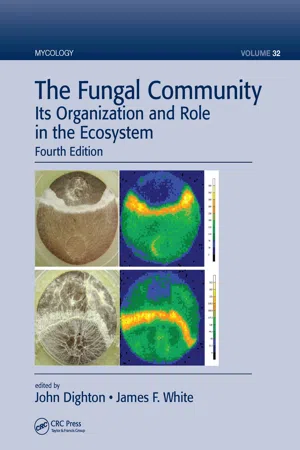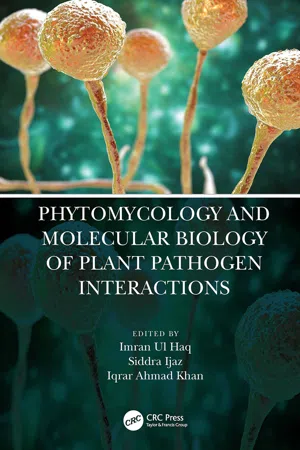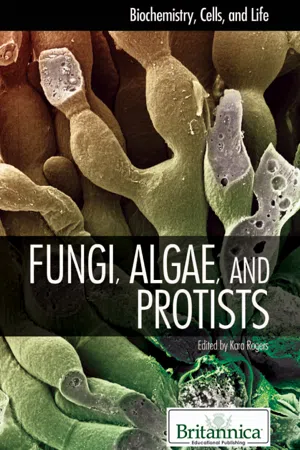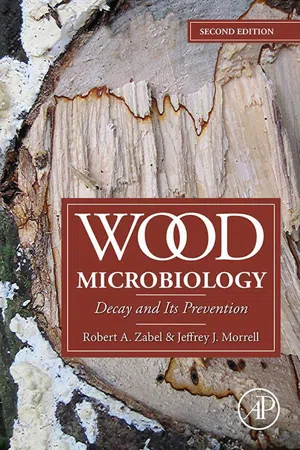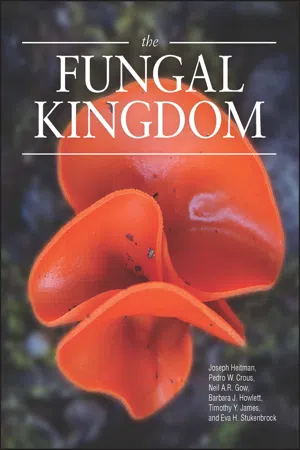Biological Sciences
Fungus Spores
Fungus spores are reproductive cells produced by fungi as a means of dispersal. They are typically small, lightweight, and easily carried by the wind or other means, allowing fungi to spread and colonize new environments. These spores can germinate under favorable conditions, giving rise to new fungal growth.
Written by Perlego with AI-assistance
Related key terms
1 of 4
Related key terms
1 of 3
8 Key excerpts on "Fungus Spores"
- eBook - ePub
Microbial Plant Pathogens
Detection and Management in Seeds and Propagules
- Perumal Narayanasamy(Author)
- 2016(Publication Date)
- Wiley(Publisher)
Among the microbial pathogens, the fungus‐like and fungal pathogens are highly evolved; they belong to the Eukaryotes, which include plant hosts and animals. They have a well‐developed body (thallus) consisting of innumerable filamentous thread‐like hyphae weaving into a mycelium. The hyphae may be septate (with a cross‐wall, referred to as a septum) or nonseptate/coenocytic (without cross‐walls, as in fungi‐like microorganisms). The cells may be uninucleate or binucleate with well‐defined cell walls. The coenocytic (nonseptate) mycelium of Phycomycotina is like a continuous, tubular, branched or unbranched multinucleate cell or multinucleate hyphae in which septa are formed later, when spore‐bearing structures are formed. The mycelium is formed by the elongation of hyphal tips produced following germination of spores/conidia. Members of Plasmodiophorales do not have a true mycelium but form naked amoeboid, multinucleate plasmodia, whereas Chytridiales produce a system of strands, known as rhizomycelium, that vary in diameter. Populations of fungal pathogens increase rapidly by means of both asexual and sexual reproduction. Specialized asexual reproductive structures such as spores, conidia, sporangia, and pycnidiospores are produced by fungi in large numbers. They germinate and grow into a new independent colony, when optimum conditions are available. Generally sexual spores are produced late in the life cycle of fungal pathogens or when nutrients become restrictive. Sexual spores such as oospores, zygospores, ascospores, and basidiospores are formed after completion of the sexual process.3.1 Biological Characteristics
3.1.1 Disease cycles of Fungal Pathogens
3.1.1.1 Reproduction of Fungal Pathogens
Fungus‐like and true fungal pathogens are carried in and/on seeds and propagules. Further, these pathogens may reach the seeds or propagules from soil, irrigation water, and air. The pathogens may infect roots, stem, and floral parts and subsequently infect the seeds. Fungal pathogen populations increase primarily in three ways. Vegetative cells may be cut off from the hyphae and grow into new individual colonies. Some cells may develop thick walls and become separated from the hyphae. These thickened cells, known as chlamydospores, are resistant to adverse conditions and germinate when optimal conditions for growth become available, forming new thallus. In the anamorphic (asexual) phase of life cycle, asexual spores such as sporangia or conidia are produced in large numbers. These spores germinate under optimal environmental conditions to form new individual colonies in the substrate. Later in the sexual phase of the life cycle, thick‐walled oospores are formed after mating between oogonia (–) and antheridia (+) in Oomycetes. Ascospores are produced in asci enclosed in ascocarps. They are ejected out at maturity and infection occurs when they reach appropriate tissues in the susceptible host plants. Likewise, the basidiospores formed from basidia infect plants, causing diseases such as smuts and bunts in cereal crops. Sexual reproduction is only possible in some of the fungus‐like and all members of Basidiomycotina when two morphologically similar, but physiologically different gametangia (+ and –), come into contact with each other. Gametangia from the same (+ or –) isolate cannot unite to produce sexual spores. This phenomenon is known as heterothallism, in which thalli of two different compatible isolates (+/–) are required for sexual reproduction as they are individually isogamous in nature. Heterothallism is common in most of the higher Ascomycotina. Basidiospores or ascospores are formed, following a union between compatible isolates which show no morphological differences. - eBook - ePub
The Fungal Community
Its Organization and Role in the Ecosystem, Fourth Edition
- John Dighton, James F. White, John Dighton, James F. White(Authors)
- 2017(Publication Date)
- CRC Press(Publisher)
Dispersal shapes the biogeography of organisms, and because dispersal is a control on gene flow, it also structures genetic diversity across populations and influences rates of speciation. Fungal spores may be dispersed long distances by air or water. Spores carried by storms or atmospheric circulation can travel between continents (Watson and De Sousa 1982; Pringle et al. 2005a; Kellogg and Griffin 2006) and research has focused on predicting and identifying rare long distance dispersal events (Brown and Hovmøller 2002; Aylor 2003; Muñoz et al. 2004). In contrast to animals, fungi are thought to have little control over the processes of dispersal, and the common view is: “…the migration of birds and mammals in search of new sites and sources of food occurs in an orderly, coordinated way with minimum wastage of progenies. Plant pathogens, on the other hand, produce enormous numbers of spores that are passively transported, scattered in all directions, and finally land on non-target sites in uncongenial environments as well as on congenial hosts” (Nagarajan and Singh 1990).While dispersal in air or water appears passive (but see Dressaire et al. 2016), fungi actively manipulate discharge. Ascomycete and basidiomycete spores are explosively launched (Buller 1909, 1922, 1924; Ingold 1971; Money 1998; Trail 2007), and the structures involved appear exquisitely engineered to propel spores into local habitats (Roper et al. 2010). Discharge is rarely considered by ecologists, and since the start of the twentieth century it has remained the purview of a handful of mycologists (Buller 1909, 1922, 1924; Ingold 1971; Money 1998; Trail 2007) and plant pathologists (Meredith 1973; Aylor 1990).While the structures used to launch spores are fascinating adaptations in and of themselves, spores also play a role in human health and the earth’s climate. Asthma and allergy symptoms are associated with exposure to spores (Salo et al. 2006; Sahakian et al. 2008; Wolf et al. 2010; Pringle 2013), and elevated CO2 - Imran Ul Haq, Siddra Ijaz, Iqrar Ahmad Khan, Imran Ul Haq, Siddra Ijaz, Iqrar Ahmad Khan(Authors)
- 2022(Publication Date)
- CRC Press(Publisher)
The spore is a fundamental reproductive unit in the asexual reproduction of fungi. The spore formation in fungi is called “sporulation,” and the spore germinates and gives rise to a new mycelium. Asexual spore is also known as “mitospore,” because it is formed by mitosis in the cell. These mitospores exhibit variation in shape (oblong, globose, oval, needle, helical), size, color (hayline, orange, green, brown, yellow, black, red), and arrangement of hyphae. Mitospores are unicellular. Curvularia and Alternaria are multinuclear. The spores are of three types: Sporangiospores Conidiospores Zoospores Sporangiospores Sporangiospores usually occur inside a sporangium (sac-like structure). The sporungium-bearing hypha, called “sporangiophore,” is branched. Sporangiospores are motile or non-motile (also known as “aplanospores”). Examples of these fungi are Rhizopus and Mucor. Conidiospores The conidium is non-motile and is formed externally on hyphae as separate cells. Conidia formed on hyphae are called “conidiophores” (conidiophores are septate or aseptate and simple or branched). Zoospores Motile biflagellate spores are called “zoospores,” and the hypha bearing zoospores is known as “zoosporangium.” These spores are produced by aquatic fungi members of Oomycete, do not have cell walls, and are motile, while aplanospores exhibit cell walls. Sexual Reproduction Sexual reproduction in fungi is less common than asexual reproduction. The sexual stage is called the “perfect state,” whereas the asexual stage is the “imperfect state.” Sexually compatible gametes or cells of opposite strains fuse in sexual reproduction. The sex organs of fungi are known as “gametangia variables” in morphological aspects- eBook - ePub
- Britannica Educational Publishing, Kara Rogers(Authors)
- 2010(Publication Date)
- Britannica Educational Publishing(Publisher)
CHAPTER 2Life Cycle and Ecology of Fungi and LichensT he abundance and wide distribution of fungi in nature are a reflection of reproductive success and adaptation to various ecological niches. Reproduction may be either asexual or sexual. In asexual life cycles, fungi are haploid (containing one set of chromosomes), and they may use fragmentation, budding, fission, or spores to produce offspring. In sexually reproducing forms, a diploid stage occurs, in which the nuclei of the haploid sex cells fuse together, facilitating the recombination of genetic material. This provides an opportunity for the emergence of genetic variation between individuals of the same species, thereby improving species adaptation to the immediate environment. Certain species of fungi are very highly adapted to their habitats, requiring specific nutrients or temperature ranges for growth. Other species, however, are less tailored to their surroundings. These fungi often are able to assimilate a wide variety of organic substances and are relatively indifferent to other ecological factors such as temperature.REPRODUCTIVE PROCESSES OF FUNGI
Following a period of intensive growth, fungi enter a reproductive phase by forming and releasing vast quantities of spores. Spores are usually single cells produced by fragmentation of the mycelium or within specialized structures (sporangia, gametangia, sporophores, etc.). Spores may be produced either directly by asexual methods or indirectly by sexual reproduction. Sexual reproduction in fungi, as in other living organisms, involves the fusion of two nuclei that are brought together when two sex cells (gametes) unite. Asexual reproduction, which is simpler and more direct, may be accomplished by various methods.Sir Alexander Fleming (b. Aug. 6, 1881, Lochfield Farm, Darvel, Ayrshire, Scot.—d. March 11,1955, London, Eng.)Scottish bacteriologist Sir Alexander Fleming was best known for his discovery of penicillin. Fleming had a genius for technical ingenuity and original observation. His work on wound infection and lysozyme, an antibacterial enzyme found in tears and saliva, guaranteed him a place in the history of bacteriology. But it was his discovery of penicillin in 1928, which started the antibiotic revolution, that sealed his lasting reputation. Fleming was recognized for this achievement in 1945, when he received the Nobel Prize for Physiology or Medicine, along with Australian pathologist Howard Walter Florey and British biochemist Ernst Boris Chain, both of whom isolated and purified penicillin. - eBook - ePub
Mushrooms
Cultivation, Nutritional Value, Medicinal Effect, and Environmental Impact
- Philip G. Miles, Shu-Ting Chang(Authors)
- 2004(Publication Date)
- CRC Press(Publisher)
Plant pathologists have long been concerned with studies of spore germination because of their interest in prevention of the spread of fungal diseases by spores. Thus, many of the techniques that have been developed for testing the effectiveness of various treatments to prevent spore germination have been developed by workers in the field of plant pathology, and certain standard procedures have been established. Of greatest interest from the standpoint of edible mushrooms, however, is the germination of basidiospores. Although the basidiospore commonly takes in water and swells as a first stage in germination, it is the emergence of the germination tube that is commonly accepted as the criterion of germination. Thus, microscopic examinations are made at intervals of time to determine the percentage of spores that have formed germ tubes, and these structures are called germlings. Besides the effects of nutritional and environmental factors on germination, the age of the fruiting body in reference to the time of discharge of the spores may also influence results, as will the density of spores in the germination chamber. Genetic factors also have an effect on spore germination.X. RELATIONSHIP OF FUNGI WITH OTHER ORGANISMS — SYMBIOSISWhether in the water, soil, or other terrestrial habitats, the fungi carry on their existence in the presence of other living organisms. Only when we take the fungi into the laboratory and establish pure cultures are the fungi truly separated during their growth from other organisms. This living together, which is the normal situation in nature for all living things, is referred to as symbiosis. Symbiosis is commonly studied by taking a particular organism, or group of organisms, and examining any special relationships that species of a different taxon may have with it. For example, the relationship of insects with pollination of flowering plants or the role of bacteria of the genus Rhizobium - eBook - ePub
Wood Microbiology
Decay and Its Prevention
- Robert A. Zabel, Jeffrey J. Morrell(Authors)
- 2020(Publication Date)
- Academic Press(Publisher)
Reproduced by permission of American Type Culture Collection and courtesy of Francis Lombard and Dr. George Chamuris.Fungal reproduction
Fungi reproduce by unicellular or multicellular spores that are formed from hyphae. They can be of asexual or sexual origin. Most spores provide a means of dissemination, but others are designed for surviving unfavorable conditions, and a few may function sexually as gametes. Many spores are very small and readily transported long distances by air currents, while others have shapes that allow them to attach to insects or float in water. Spores of some fungal groups are forcibly ejected into the air, while others are sticky and appear to be adapted for dissemination by insect vectors. Asexual spores are formed directly from a hypha without a meiotic division. Sexual spores are formed from hyphal cells where nuclear fusion (karyogamy) and meiosis have preceded the separation into spores.Asexual spores: There are many types of asexual spores formed by fungi. This review will consider primarily the common types found in wood-inhabiting fungi. Conidium is the general term used for most asexual spores formed by members of the Ascomycota and Basidiomycota. Conidia have several very different modes of origin which are important in many classic taxonomic keys.Arthrospores or oidia are conidia formed by the fragmentation of an existing hypha by separation of the septal walls. This type of conidial origin is termed thallic. Some wood decay fungi (Gloeophyllum sepiarium , Phlebiopsis gigantea , and Bjerkandera adusta ) form abundant arthrospores in culture. In some fungi, such as the yeasts and the wood staining fungus Aureobasidium pullulans , the cell wall softens in a localized zone, balloons out, and forms blastospores by a budding process. This type of conidial origin is termed blastic and the conidiogenous cell enlarges generally prior to septal formation and conidium release. There are several types of blastic conidial development. When the outer and inner walls of the conidiogenous cell are involved, conidia formation is called holoblastic . When only the inner wall is involved or a new wall is formed, the process is termed enteroblastic . Conidia formed by some wood-staining fungi (Ophiostoma coerulescens - eBook - ePub
- Joseph Heitman, Barbara J. Howlett, Pedro W. Crous, Eva H. Stukenbrock, Timothy Yong James, Neil A. R. Gow(Authors)
- 2017(Publication Date)
- ASM Press(Publisher)
Fungal spores are orders of magnitude smaller than the smallest seeds—smaller than most moss and fern spores and comparable in size to some plant pollen (e.g., Triticum aestivum, or wheat, pollen) (37 – 40) (see Fig. 2 and 5). However, unlike pollen, many fungal spores are short-lived and highly susceptible to desiccation and UV radiation, and it is often unclear whether spores survive, e.g., transcontinental and oceanic transport (41 – 45). Given these taxonomic, empirical, and methodological challenges, a sound conceptual framework to guide and synthesize research is urgently needed. Mycologists have yet to integrate the abundant physiological, morphological, and biogeographic data available for hundreds of species into a unifying paradigm of fungal LDD. If comparisons are to be effective or relevant, the highly relative nature of the spatial scales involved must be explicitly acknowledged in any discussion of LDD (46). DEFINING FUNGAL LDD In a general framework focused on dispersal, Nathan (28) highlights two general definitions of LDD that are often used in studies of animals and plants: movement exceeding (i) an absolute threshold equivalent to a chosen distance (e.g., 100 km) and (ii) a relative threshold based on a fraction of propagules found at the tail of a dispersal kernel (e.g., 99th percentile and above). However, a translation of these definitions to research on fungi is hindered by the incommensurate priority given to plants and animals in dispersal ecology (cf. 47 – 49) and by a lack of appropriate empirical data (e.g., spore sources are often inferred through reverse trajectory models that reveal little about source inoculum density, making inferences about fungal dispersal kernels [required by definition ii] difficult) (1, 28, 50). Moreover, definitions involving absolute threshold distances involve discretionary demarcations of LDD, resulting in a lack of consistency among studies - eBook - ePub
- Thomas N Taylor, Michael Krings, Edith L. Taylor(Authors)
- 2014(Publication Date)
- Academic Press(Publisher)
Kuang et al., 2012 ) and might be interpreted as a chytrid zoosporangium on the surface of the grain.Figure 11.1 Alfred Traverse.Naming Fungal Spores
One of the first systems for classifying fungal spores by comparing features with those of modern analogues relied on conidial characters of size, shape, color, and degree of septation. This system was proposed by Saccardo et al. (1882–1931), and the multivolume work, Sylloge fungorum omnium hucusque cognitorum , in which they assembled details of all the fossil species published up until 1920, was a monumental accomplishment; additions and corrections were later made by Kirk (1985) and in subsequent editions. The initial system was modified by van der Hammen (1954a, b), who assigned groups of pollen and spores to various morphological categories and had the suffix -sporites added for fungal spores; later, Clarke (1965) suggested the suffix -sporonites be used to indicate that the genus was of a fossil spore. Surface texture, including ornamentation, and color have also been used in defining some fungal spores (Elsik, 1976a , b , 1983 , 1996 ), and there is now some uniformity in the terminology that has been developed and refined for pollen and spores (e.g. Dominguez de Toledo, 1994 ; Punt et al., 1994 ). Because the shape of the fungal spores may be variable, Kendrick and Nag Raj (1979) (Figure 11.2 ) modified the system to remove inconsistencies and provide greater resolution for some features.Figure 11.2
Index pages curate the most relevant extracts from our library of academic textbooks. They’ve been created using an in-house natural language model (NLM), each adding context and meaning to key research topics.
Explore more topic indexes
Explore more topic indexes
1 of 6
Explore more topic indexes
1 of 4
